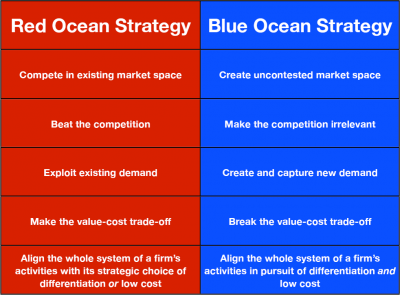
How to Create a Blue Ocean: Part 1
Business these days seems to be about who can make more money than the other. In an ever-growing and globalising world, there’s no doubt that almost every market is extremely competitive, but there always seems to be news of a new idea or concept that simply grabs the world’s attention and seems to completely capitalise on it, becoming a powerhouse in the market that itself had created — Uber, anyone?
But where do these companies come from? Sure, they start with ideas, but ideas are simply just that until someone makes a growing, thriving business out of it. That’s where the Blue Ocean Strategy comes into play.
Red Ocean vs. Blue Ocean
A business concept devised by professors W. Chan Kim and Renée Mauborgne in 2005, the Blue Ocean Strategy is the simultaneous pursuit of differentiation and low cost to open up a new market space and create new demand.
Competitive markets are seen as red oceans, where (with gruesome imagery) sharks strive to tear each other (and anyone else) to pieces. Whereas, the blue ocean concept is essentially where no “sharks” infest and where a business can thrive and grow without massive competition.
Value Innovation
The backbone to the Blue Ocean Strategy is the value innovation framework. Costs are decreased by eliminating and reducing the factors that an industry competes on, and buyer value is increased by raising and creating elements that the industry has never offered. Over time, the superior value generates high sales volumes while costs continue to decrease.
8 Principles of Blue Ocean Strategy
A successful blue ocean creation includes a lengthy process of strategy formulation and execution, so I’ll try to summarise as much as I can for you. Here are the eight basic principles in creating a blue ocean strategy:
Formulation
- Reconstruct market boundaries
- Focus on the big picture, not the numbers
- Reach beyond existing demand
- Get the strategic sequence right
Execution
- Overcome key organisational hurdles
- Build execution into strategy
- Align the value, profit, and people propositions.
- Renew blue oceans
What I’ll be focusing more on is the formulation principles, as they apply more to a small business and startup market.
Reconstruct Market Boundaries
There are six approaches you can take to reconstruct the market boundaries and create a blue ocean. You don’t necessarily have to take just one, but you can make a combination of approaches to see what best suits your potential customers.
6 Pathways of Blue Ocean
Path 1: Look Across Alternative Industries
Substitutes are different things that perform the same function, whereas alternatives are things that perform different functions but fulfil the same objective.
Two different types of restaurants are substitutes (like Italian or Mexican), but a restaurant and a cinema, although unalike, are alternatives as they offer different things, but fulfil the same objective — a good night out.
Path 2: Look Across Strategic Groups Within Industries
A strategic group is essentially the target market(s) you’re aiming towards. What you’re wanting to look to is the middle ground; try to understand what they would do to trade either up or down, to your offering.
Path 3: Look Across the Chain of Buyers
There is a chain of buyers behind every purchase, which can start at the buyer, end up at the user, and even originate from an influencer. Look towards how you can capture those who aren’t simply the buyer (already your customers).
Path 4: Look Across Complementary Product and Service Offerings
There are many factors that contribute to purchasing a product or service that are outside of the particular industry’s control. For example, as a couple with a young child, you’d have to hire a babysitter to go to the cinema, and then find parking and possibly pay for it. But, imagine a cinema with a childcare service.
Path 5: Look Across Function or Emotional Appeal to Buyers
There are two basic appeals that products and services can have: one on price and function, and one on feelings and emotion. If the industry thrives off of one appeal, trying increasing the other in your blue ocean offering.
Path 6: Look Across Time
This requires you to look into future possibilities for trends. It’s a more difficult pathway, but well worth it. For example, Apple realised that CDs were being consumed by the illegal, digital music-sharing trend of the late 90’s and early 00’s. The trend towards digital music was clear, and hence the iPod was born, and soon after, the iTunes online music store.
Focus on the big picture, not the numbers
Numbers aren’t necessarily what’re the most important things to monitor at this stage. The big picture/the whole process, and strategy is what should be in mind. The Visualisation strategy can be used to understand where your business is and where you want your offering to be in the market.
Four steps of the Visualisation Strategy
| 1. Visual Awakening | 2. Visual Exploration | 3. Visual Strategy Fair | 4. Visual Communication |
|---|---|---|---|
|
|
|
|
A strategy canvas, is basically a line graph that roughly shows your what your products look like compared to other business’ products (As Is canvas), and then what your potential blue ocean product offering would look like compared to other alternatives (To Be canvas, as shown below).
Essentially, you would want your To Be canvas’s blue ocean offering to look completely different to any other potential competitors’, which is the point of differentiation. More information on strategy canvases can be found here or in the Blue Ocean Strategy book.
How to Create a Blue Ocean: Part 2 highlights the last two formulation principles for creating a blue ocean: reaching beyond existing demand and getting the strategic sequence right.



